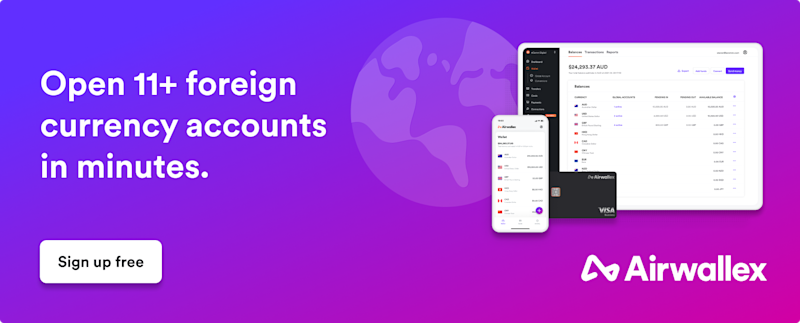There are numerous reasons to expand your business internationally. You can expand your customer base, capitalize on favorable foreign market conditions, boost your revenue, and more.
But making the leap from domestic to international sales can seem daunting. If you’re wondering how to sell online internationally, Shopify is a great place to start.
Let’s take a look at why Shopify lends itself to global eCommerce and how to sell on Shopify overseas.
Why sell internationally with Shopify?
Shopify offers several features that make it easy to sell globally.
Note: Not all Shopify plans offer the same features. Be sure to check out and compare their various plans before making a purchase.
Simple currency conversions
According to data collected by Shopify, adjusting product prices to the local currencies of international customers increases conversion rates by up to 40%. This comes as no surprise: Customers want to know how much they’ll end up paying in their own currency – without going through the trouble of converting prices themselves.
🛒Top tip: Plug Airwallex into your Shopify checkout and accept multi-currency payments without unnecessary fees. Collect international customer payments directly into your Airwallex Global Account without being forced to convert funds to your home currency. Then pay out to international suppliers using Corporate Cards and Transfers.
Translation
You probably know from personal experience that reading product descriptions in a foreign language doesn’t make for the best customer experience.
The numbers back this up: 40% of global consumers won’t buy products that are marketed in a foreign language, according to a Common Sense Advisory research series. And 65% prefer content in their native language.
The bottom line is clear – if you don’t provide translations, you’re shooting yourself in the foot.
International domains
Shopify helps you go even further in your localisation efforts with international domains.
International domains not only make it easier to localise currencies and languages but also enable you to improve your search engine optimisation (SEO) by geotargeting. For those who aren’t SEO experts, this means delivering different content to visitors from different locations.
Furthermore, you have the option to choose either a country domain or a subdomain, which makes targeting a specific country or market even easier.
Local payment methods
One of the most effective ways to earn potential customers’ trust and facilitate purchases is to offer their preferred payment methods.
After all, if they don’t have – or it’s inconvenient to use – the required payment method, you’ve likely lost a sale. On the other hand, offering preferred payment methods can increase conversions when selling products abroad.
🛒Top tip: The Airwallex Shopify integration allows you to offer multiple local payment methods on your website. Including Alipay, WeChat Pay, Klarna, Union Pay, and more. Increase global sales by allowing your customers to pay you the way they want, wherever they are.
Taxes and fees
Concerns about additional taxes or fees are one of the biggest obstacles for buyers looking to purchase from a foreign site.
Buyers want and need to know whether the total on the checkout page is the amount that the shop will charge their card. Confusion surrounding this can lead to everything from lost sales to chargebacks.
Shopify international sites collect duty and import taxes directly at checkout. Customers will enjoy complete clarity into their total cost, and you can be sure that your shop complies with local requirements.
Customizable market configurations and smart settings
Worried about managing your site after you expand? Shopify simplifies the process by allowing you to manage all your settings across markets from a single location.
At the same time, Shopify provides data and insights from past customer behaviour to help you make informed decisions. Review your business’s current performance in your selected markets and optimise to improve your international success.
Custom market-specific pricing controls
Measuring profit margins can be challenging when selling products abroad in multiple markets. After all, factors such as duties, taxes, and shipping vary from one country to the next.
As a result, you’ll likely need to develop different pricing strategies for different markets.
Shopify makes this easy with custom international pricing controls. Make percentage-based adjustments by market, or product-specific changes – whatever makes the most sense to increase your margins.
🛒Top tip: Manage all your funds in one place with an Airwallex Global Account. Open foreign currency accounts in a click, and collect customer payments from around the world into a single multi-currency wallet.
Market-specific inventory and fulfillment
If you plan to sell in multiple markets, chances are you’ll need to store inventory in several locations.
Luckily, Shopify’s Markets feature makes it easy to display only the inventory that you can ship to the country that the customer is located in.
For instance, imagine you have a UK location that ships across Europe and a US location that ships within North America. Your European visitors will see only the inventory available at your UK location.
This may sound overly simple, but it can go a long way towards preventing logistics complications.
How much does it cost to sell internationally with Shopify?
Shopify charges a set monthly fee in addition to credit card and transaction fees. These costs depend on the plan you choose.

Sources: Basic, Shopify and Advanced Plans; Shopify Plus Plan; Currency Conversion Fees
You can sell internationally with any of these plans. All provide features like international market management, country-specific domains, language translation, currency conversion, and local payment methods.
However, certain plans are better geared towards international selling.
For example, with the Shopify plan and above, you can set custom rounding rules for your prices per market – such as having all your UK prices end in £0.99 and all your EUR prices end in €0.90.
The Advanced plan offers even more benefits, such as market-specific pricing and duty and import tax collection, which give customers greater clarity into their total cost.
Also keep in mind that you’ll enjoy lower credit card rates and external transaction fees with each plan upgrade.
[Related: The best payment gateways for international eCommerce]

How to reduce international Shopify fees
Now that you know how much selling international products on Shopify might cost you, let’s look at how you can reduce your fees.
You can’t exactly get around the costs associated with your Shopify plan, credit card rates or transaction fees, but conversion fees are a different story. Shopify itself best explains how these fees work:
When you accept payment in a currency that is different from your payout currency, a currency conversion occurs. The amount that you receive in your customer's local currency (also referred to as the presentment currency) is converted to your payout currency, and you’re charged a currency conversion fee.
To avoid conversion fees on Shopify international payments, you need to avoid having to convert your funds in the first place. You have two options to do this.
One option is to set up a local bank account in each country you plan to sell in.
For example, imagine you’re a UK business that wants to sell in France. You open a local euro bank account and connect it to your Shopify account. Now, whenever you make sales in France, you send the revenue directly to your new euro bank account – effectively avoiding conversion fees.
The downside of this option is that banks also charge high conversion fees (up to 3.5%) and transfer fees. So, although you may postpone additional charges, you’ll eventually have to pay them when you’re ready to transfer funds back to the UK. Banks also charge monthly account fees, so excess bank charges could cancel out any money you save.
Luckily, you have another option: to open a Global Business Account with Airwallex.
Airwallex Global Business Accounts enable you to collect Shopify international payments in multiple currencies – including pound sterling, euros, USD, and more – from your Shopify account into a single multi-currency account. No forced currency conversions or transfer fees apply.
You can hold funds in your multi-currency account for as long as you want, and use them to pay international suppliers, SaaS subscriptions, and more, all while avoiding FX fees.
If you do want to convert funds into your local currency, we charge only 0.5–1% above the interbank exchange rate. That’s significantly lower than Shopify, which charges 2% outside the US, and traditional banks, which charge 2–3.5% above the interbank rate.
As a result, your business could save thousands, depending on your sales volume. And you can do all this without dealing with multiple foreign banks or a complicated payment instructure. Instead, manage your money from a single central account.
For more information, compare Airwallex against other business accounts here or sign up for a free account.
How to identify new markets
Once you decide to sell internationally, you must decide where.
Remember that you want to provide a shopping experience that’s tailored to each specific market, so selling anywhere and everywhere would be a massive undertaking. Furthermore, your product offerings are likely more attractive to certain markets.
To narrow your options, start by visiting Shopify’s analytics section to check out your “sessions by location” acquisitions report. This report shows you which countries your visitors are from.
Do you already have some vvisitors – oreven sales – from a specific country? That’s a great indication of demand for your products from that international market. You should take a closer look at it.
Don’t worry if you don’t yet have any international visitors – that doesn’t mean selling internationally isn’t viable. Instead, look for markets that appear to have strong demand for your products. Explore markets in countries with these attributes:
Share the same language as you
Are close to you in proximity
Have cultural similarities
Show similar purchasing habits
With these tips in mind, select one to two new markets to expand into.
How to fulfill your products abroad
Selling international products involves more than just setting up your website to target a new market. Before making sales, you must be prepared to deliver products to international customers.
Fulfilling your products involves three main steps:
Importing. Shipping individual products to foreign customers from your original warehouse probably doesn’t make sense if you’re working with a considerable volume. Instead, import products directly to your new market areas to reduce shipping costs and times. Just be sure to have the necessary paperwork to clear your products through customs.
Storing. Be sure to shop around for a reliable (and cost-effective) warehouse or storage unit to hold your inventory. And remember that Shopify offers market-specific fulfillment controls that let you source products from select inventory locations for select markets.
Shipping. The question isn’t so much, “Does Shopify ship internationally?” — it’s more a question of how! Shopify Shipping makes it easy to deliver orders by letting you purchase international shipping labels directly from your account and automatically generating the correct customs forms for you.
[Related: The ultimate guide to paying overseas suppliers]

How to improve your global sales on Shopify
So, you know how to sell products on Shopify, and you’re ready to get started. How do you ensure your efforts succeed?
Localise, localise, localise
If you’ve made it this far, you already know why localisation is essential to your international expansion and how Shopify facilitates the process. But let’s look again at the most important steps:
Translate your content. Customers strongly prefer to purchase products in their native language. Ensure all text (from your product descriptions to your landing pages) is translated to create an ideal customer experience.
List local currencies. Don’t make customers do conversions themselves — update product prices to reflect their local currency, and collect multi-currency payments directly into your Airwallex Global Account using our seamless Shopify integration.
Offer local payment methods. Simplify the checkout process for customers and increase conversions by offering local payment methods. Airwallex makes this easy: With our Shopify integration, you can offer multiple local payment methods at your checkout, including WeChat, Alipay and Skrill.
Create international domains. Take your localisation even further with international domains to target certain markets.
Be aware of local holidays
Sales typically spike during specific shopping periods throughout the year, but don’t assume those periods will be the same in your new markets.
For example, Black Friday and Christmas dominate in the West, but sales peak on Singles Day across Asia.
Failing to note these shopping habit differences can cause inventory shortages or overages – not to mention missed opportunities.
Advertise
A strategic marketing plan is essential to ensure that all your website localisation efforts don’t go to waste. What’s the point of having a targeted website if no one sees it?
And like when choosing new target markets, remember that one size doesn’t fit all when it comes to marketing. Develop market-specific advertising campaigns that target buyers in that area and direct them to the appropriate version of your website.
Take your eCommerce business global with Shopify and Airwallex
If you’re ready to sell globally and want to simplify your expansion, Shopify may be the ideal solution. Utilize Shopify’s numerous features designed for international selling to expand your customer base rapidly.
To further simplify the financial side, Airwallex is ready to help you collect payments in local currencies, localize your checkout, and reduce fees.
View this article in another region:AustraliaEuropeHong Kong SAR - EnglishHong Kong SAR - 繁體中文United KingdomGlobal

Airwallex Editorial Team
Airwallex’s Editorial Team is a global collective of business finance and fintech writers based in Australia, Asia, North America, and Europe. With deep expertise spanning finance, technology, payments, startups, and SMEs, the team collaborates closely with experts, including the Airwallex Product team and industry leaders to produce this content.
Posted in:
TransfersShare
- Why sell internationally with Shopify?
- How much does it cost to sell internationally with Shopify?
- How to reduce international Shopify fees
- How to identify new markets
- How to fulfill your products abroad
- How to improve your global sales on Shopify
- Take your eCommerce business global with Shopify and Airwallex


